Trainer Tom Dokken at home in South Dakota with his Lab, Chase. Bill Buckley
If you’ve ever owned a bird dog, then you’ve probably got Tom Dokken to thank. Maybe you read his book or used the check cord he designed. You almost certainly bought a Dead Fowl Trainer (or an imitation of one) to teach your pup the proper hold on a bird. Or maybe you sent your dog off to a trainer who read Dokken’s columns or attended his seminars, or maybe even trained under Dokken himself.
During his five-decade career, Dokken founded Oak Ridge Kennels, developed his own line of retriever-training products, and helped loads of amateur trainers like me. He has trained thousands of gun dogs and helped reshape gun dog culture in America. At 69, Dokken is still operating his kennel, training dogs himself, tinkering away with new inventions, and hunting hard. And even though there are more pro trainers now than ever before, more training videos, more online tutorials, and more “experts,” Dokken’s training method and philosophy are just as important today as they were decades ago.
As a Minnesotan by birth and South Dakotan by residency, hunting, farming, and manners are programmed into his DNA. Dokken doesn’t swear, instead relying on Midwestern standbys like “geez,” “jeepers,” and “goat rope.” When presented with a problem, he doesn’t stall or gripe. He solves it.
Part of what makes Dokken an elite trainer are those Midwestern roots. With his dogs, he’s mild mannered but firm. He’s friendly without overpraising. When a dog makes a mistake or is willfully disobedient, he never loses his temper. Tom Dokken is, above all else, even keeled. The dogs he trains recognize that confidence and authority, and respect it.
And so do their owners. Because when you train with the best, you can’t help but feel you and your dog are going to become the best you can be, too.
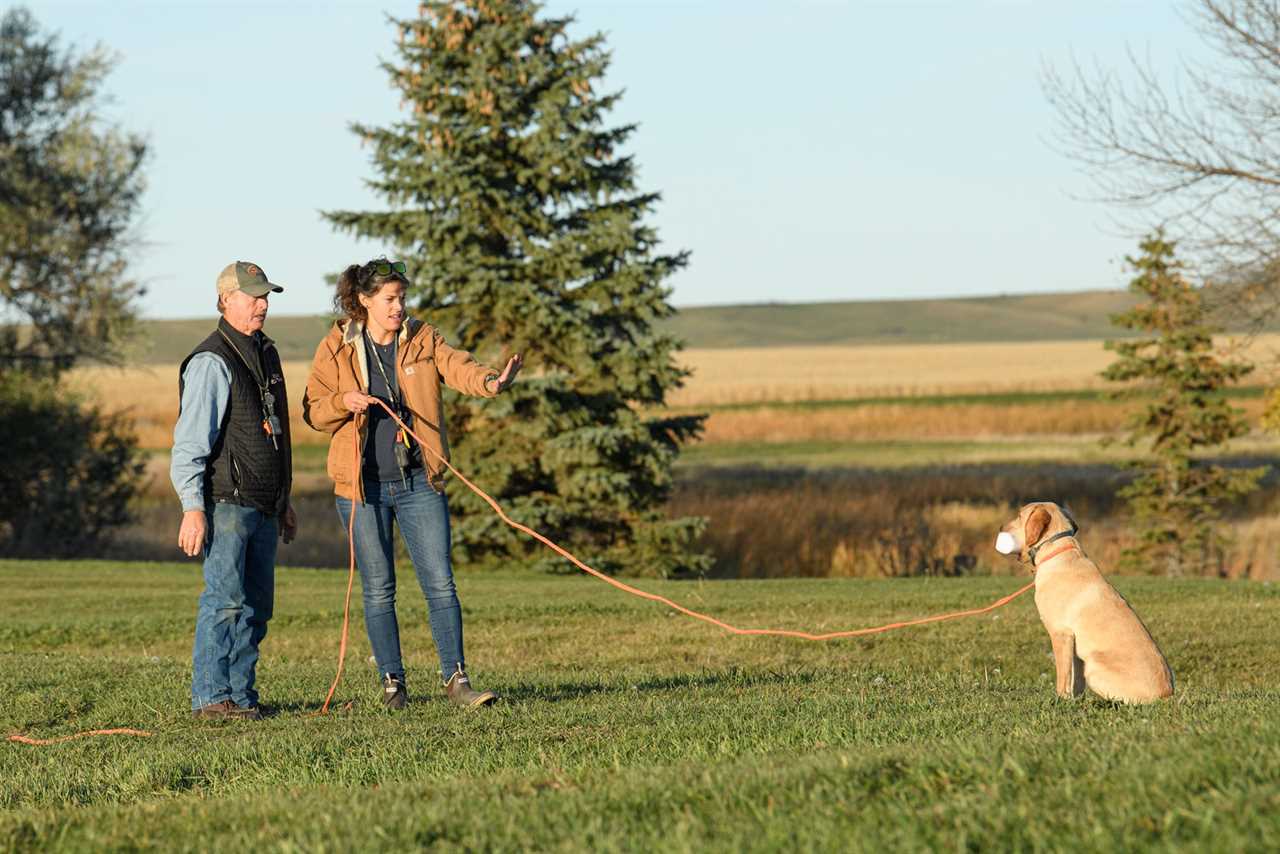
Training with Tom Dokken is instructive for both the author and her pup. Bill Buckley
The Dokken Philosophy
When Dokken began his career, trainers would get one-year-old or older dogs—an experience he’s likened to “wrestling alligators.”
“You wouldn’t see them when they were young. We started a two-week bird and gun program [for pups as young as five months] when I started my own business. It’s so much easier to see them at that age. Their drive is up here, just below the surface,” Dokken says, holding his hand high. “The older they get”—his hand drops steadily—“the harder it is to access that drive. If there are social or developmental issues, now’s the time we can actually do something with them [to address it].”
Dokken won’t say he was the first gun dog trainer to take on such young pups, since he can’t be sure what was happening nationally in the 1970s. But it was a new approach at a time when hunting dogs lived outside and weren’t part of our families the way they are today.
“I don’t want to take credit for that stuff, but it had a huge impact on not just our [bird and gun] program, but how it set the stage for the next course, which is finishing training. We got them on the right path right away.”
Dokken got a look at my yellow Lab, Hatchet, when he was six months old. We’d been invited to the Dokken’s home in South Dakota for summer training before Hatchet’s first bird season. I’d taken care to socialize my pup and run him through the obedience outlined in Dokken’s book, including a basic introduction to birds, but I had no experience training a gun dog.
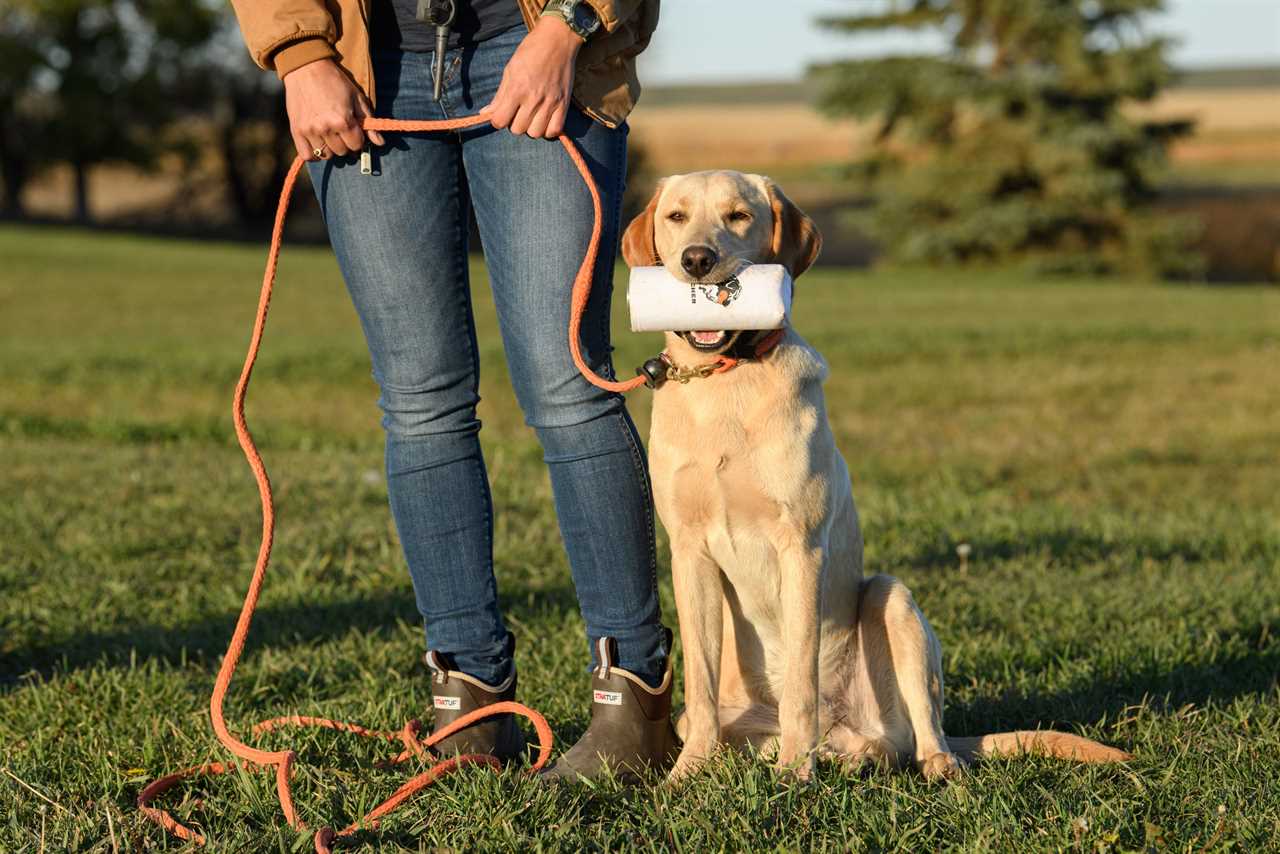
The author’s dog practices his hold. Bill Buckley
Instead of slinging advice or plowing into a textbook bird-and-gun program, Dokken simply observed us work together. He studied our progress without judgement, and asked questions to better understand Hatchet’s temperament and drive because, as he noted, I know my dog best. I knew Hatchet to be eager to please, steady, a reluctant recaller, weak on land retrieves (due to our recall troubles), and a strong retriever on the water.
Soon Dokken prescribed a regimen of fun bird and gun introduction, where he cut my pup loose on clipped-wing pigeons with the guidance of a check cord. Dokken studied Hatchet’s body language closely at each step—if he twitched or looked at all uncomfortable, they would back up. Dokken ran through a gambit of clapping, shouting, .22 blanks, and 20-gauge shells, making noise at a distance with each and moving closer until he could unload a 12 gauge over Hatchet’s head without a twitch.
Only once did a session veer off track, when two pigeons in a row escaped without Hatchet getting a retrieve. Unperturbed, Dokken produced more pigeons from his vest like a stage magician. Even Dokken, a superb shot and expert pigeon wrangler, had planned for the worst-case scenario, and was still able to set Hatchet up to succeed.
“He’ll always ask you what could happen, and if that happens, how are you going to react?” says Tina Dokken, who has been training with her husband for two decades. “What are you going to do to correct the dog’s mistake? He’s trying to get you to be prepared that those things will happen, because timing is everything with these dogs. He does that so you, the trainer, can make mistakes ahead of time—before you make them on the dog.”
My mistakes were easily corrected under Dokken’s guidance. Our recall trouble was fixed in a single day of check cord work and e-collar reinforcement. As we advanced through Hatchet’s intermediate training, Dokken asked me to handle his own dog, a sleek black Lab, and Tina’s older chocolate, so I could get comfortable with hand gestures, timing, corrections. These veteran Labs would be resilient to my slip ups.
Any time we introduced Hatchet to something new—the heeling stick, the force fetch table—Dokken showed me how to make positive associations with those tools before adding discipline. We let him smell the heeling stick and even pet him with it well before using it to fine-tune his heel work. In the days leading up to his first force-fetch session, he’d eagerly leap into place on the force-fetch table, where he got plenty of affection.
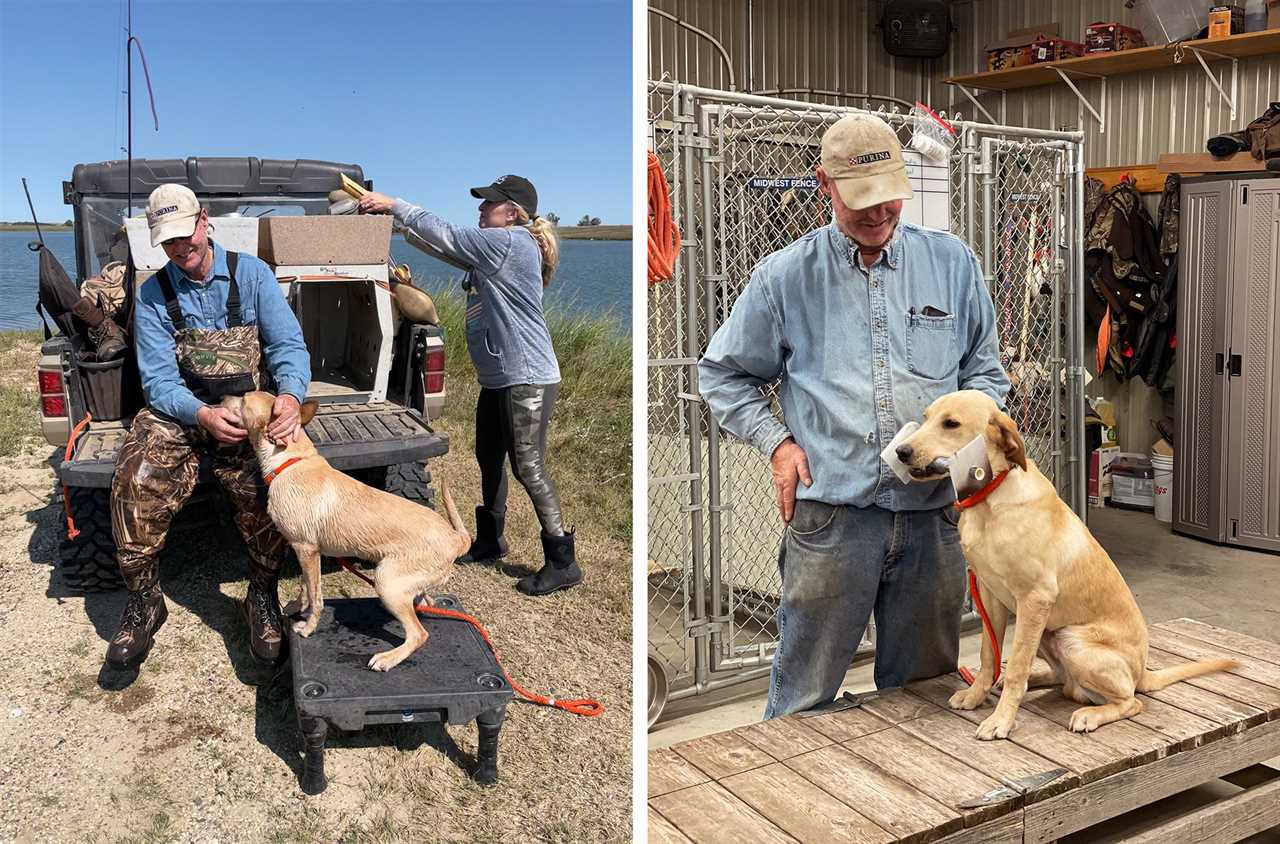
A moment of praise for Hatchet after a good session of cripple training with a diving DFT fixed to a fishing rod; demonstrating a new phase in force fetching so the author understands exactly how to run through the drill. Natalie Krebs
“Some dogs can be pushed, some dogs you have to take a really slow approach, because you have to keep them working,” says Dokken, who trains pups from varying qualities of bloodlines. “Too much control on some dogs early will take drive away. A dog with super high drive? You need to start controlling that right away. Those are the things we find out early. When we do bird and gun, we’re getting that glimpse of drive level and personality.”
Because Oak Ridge Kennels trains hunting dogs, Dokken’s trainers must use bird and gun sessions to build drive and desire.
“We don’t have the luxury of washouts,” Dokken says. “If someone is running field trials, that’s a high percentage of dogs that won’t move on. For us, the family is not going to go, Daisy isn’t really working that well, we’re getting rid of her. Not gonna happen. So you have to do anything and everything to get any kind of drive level. That’s a challenge, because you have to really know all the tricks to pull the drive out. At five months, it’s easier to access it. At a year if they’ve had no bird contact? That’s tough.”
Those tricks (and he really means tricks—this is not recommended programming) include creative problem-solving to get disinterested dogs to pick up birds. If your dog shows some interest but won’t pick up a pigeon, drop the bird in two-foot-tall grass. The pup might grab it and drop it in the short grass for a better look. If the dog is a good swimmer, maybe you try a water retrieve. They’ll grab it and drop it on shore to look at it, but most importantly, you got the dog to pick up the bird. A retriever that loves playing keep away (a bad habit Dokken can fix in a day) might be persuaded to pick a bird up if it thinks you’re going to grab it.
“We need to get to the end result [of a capable gun dog], but we have to evaluate the dog first. They’re like people,” says Dokken, who studies a dog’s drive and personality. “It’s like a team sport. You’ve got your super athletes, where all they want to do is practice and practice and then play, and some players who are just there because their buddies are there.”
I hazard a guess at Hatchet’s psychological profile: Craves approval, can handle some (but not a lot) of pressure, and a mixed drive. He’s lukewarm on drills but loves to hunt birds.
“I think where Hatchet is at, he needs lots of opportunity now,” Dokken says diplomatically. “He needs to get out and hunt, get birds killed in front of him. He’s been on the practice squad. You need to put him in the game.”
The Making of a Legend
Long before he began avoiding towns with populations above 500, Dokken grew up in the suburbs of St. Paul. He had started hunting with buddies north of the Twin Cities when they were 14, those hopeful outings where “you’d go out, but you’d never get anything.” That slump ended his junior year.
“It was like, geez, this is the real deal,” says Dokken, who had tagged along with his dad’s friends one morning. “We’re seeing ducks, we’re shooting our guns. There wasn’t a dog on that first trip, but it’s what planted the seed.”
Although the teenager badly wanted a bird dog, his parents thought their only son was too busy with football, hockey, and baseball. After graduation, Dokken left for a small college in Minnesota and a spot on the football team. That lasted a semester.
“It’s like, how many classes can you miss because you’re hunting and still be in school? School just really wasn’t for me. Even in high school. School was for sports, and you just put up with going to class.”
Instead, Dokken started working second shift at a computer company and spent all his free time hunting with his high school buddy, Bruce Knowlan, who ran field trials with his Labs. The two dragged Dokken’s camper all over the northern U.S. and Canada, bowhunting caribou and shooting ducks and living the dirtbag lifestyle long before it was glamorized like it is today. Through Knowlan’s field trial contacts, Dokken bought a 5-month-old Lab pup, a black female he named Dyno—short for Dynamo.
“I wanted to hunt, but I started running trials too. We worked every day. She liked to work, and we figured things out together. And she was very successful, especially at a very young age,” says Dokken, crediting Dyno’s drive and the time they spent training rather than his own skill. A year later, the young Lab was on the national derby list and running competitively in the highest level of field trials. “I didn’t know that you weren’t supposed to be able to do that [with such a young dog], but we did. A lot of people paid attention. Like, what’s that guy doing there with a year and a half old dog and running in the Open?”
The pair started training with more experienced handlers. Soon Dokken took a second job cleaning kennels for Jim Kappes, Dyno’s breeder. Grunt work—feeding dogs, hosing stalls, catching pigeons—eventually gave way to a full-time trainer position as the kennel grew to accommodate some 60 dogs, mostly hunting and field trial Labs. (Minnesota hunters, Dokken explains, are especially partial to Labs.) When the harsh Minnesota weather settled in, Dokken would load the dog trailer and head south for the winter to train and trial.
By his mid-twenties, Dokken was ready to start his own kennel. He bought a building with a fellow trainer, but they quickly realized the facility was restricted by city ordinances and too small for the growth they envisioned. The men parted ways and, truly on his own now, Dokken purchased a building in Northfield, Minnesota, and named the business Oak Ridge Kennels.
“I didn’t know I couldn’t do it,” Dokken says of those early years. “Which was probably a good thing. It was apparent from the first kennel [I worked at] that the business was there, and I could make a living at it. Could I be prosperous? That’s another story.”
Four decades later, it’s a 70-dog operation with four full-time trainers plus office and facilities staff. He doesn’t hire trainers from other outfits who have their own ideas about hunting dogs, but rather trains them to the Dokken program from the ground up—just like the dogs. Over the years, many of these trainers have gone on to start their own kennels and programs, and many have been quite successful. In this way, Dokken’s training philosophy has expanded across the country.
Show Business to Businessman
In the 1970s, Dokken landed a slot at the Minneapolis Sports Show to put on an hour-long retrieving dog act. It was a big deal in an era without hunting TV channels or YouTube, and thousands of spectators saw what well-trained gun dogs could do. Demand for Dokken’s training services exploded. Then a talent agent from New York City began booking his act at other sporting shows across the country. Dokken spent his winters on the road, staying at motels in major cities with up to six dogs and putting on as many as three shows a day.
A pointer would work across the stage and lock on point above a fake bush, where another dog would pop out. Or if the auditorium was big enough, Dokken would place a retrieve way up in the grandstand and handle a retriever to a bumper. The finale featured a simulated goose hunt complete with a blind, honking playing over the loudspeakers, shotgun blanks, and a goose that looked a lot like an early Dead Fowl Retriever dummy splashing down into a pool for a retrieve. Most of the dogs were his client’s dogs, although Dokken’s own Lab would play the clown since it required some tricky training. The clown’s job was to make the audience laugh by doing the opposite of whatever Dokken asked.
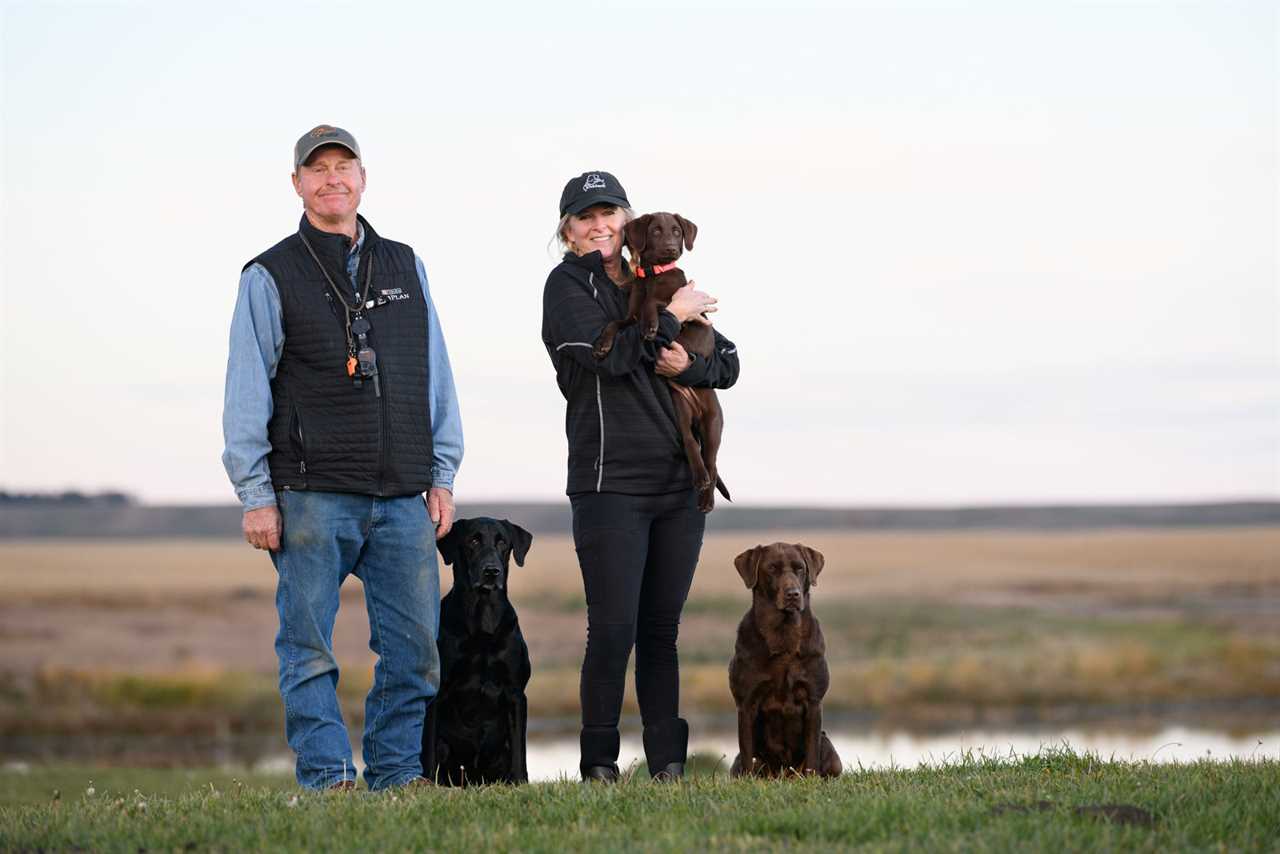
Tom and Tina Dokken with their retrievers. Bill Buckley
“It was entertaining, and it was fast-moving,” says Dokken. “There’d be an emcee and he’d be explaining it while we’re going through everything. So having four dogs up on stage at a time, one dog working at a time without the others running around crazy—it was a lot.”
As sporting shows phased out in the early 1990s and his training business continued to grow, Dokken started to focus more on product development.
“I was always just modifying stuff that we used just to fit what we needed,” says Dokken of the early versions of the Dead Fowl Retriever and other home-made products that cropped up in his act. “Different small things just to make life a little easier. Like, okay, how can we make this more efficient?”
The Dead Fowl Trainer, or DFT, is a foam-injected mold of a game bird’s body with hard plastic feet and a hard head that dangles by a string. It’s designed to shape a retriever’s proper hold of a bird: securely but gently around the middle, since most dogs will avoid a pair of plastic feet poking them in the palate. He can’t remember exactly when he started tinkering with the DFT, he just knows that Dokken Dog Supply began in 1995, after which the company secured a patent and launched the mallard DFT in 2000.
“It was an adventure. I always say, ‘If I knew what it would’ve taken now, we wouldn’t have gone through all the headaches.’ But you don’t know that when you start.”
By “we,” Dokken really means himself, even if he’s reluctant to take credit for his own accomplishments. “I’m like, what do you have a mouse in your pocket?” his wife, Tina, likes to joke. “He’s the most humble person I know.” Dokken attributes the initial success of the DFT not to its usefulness as a training tool, but to its shelf appeal.
“I don’t know if people bought it originally for the things it does, other than the fact that it looked like a duck. Well, and the dogs just love them. I think it’s the feel of the body and the fact that the head moves—it feels to a dog like it’s a real thing. Then we made different species. I remember a guy came up to me and said, ‘I really like your product but I don’t use it.’ And I said, ‘What do you mean?” The guy said, ‘I have a springer spaniel and I hunt pheasants.’ Well, it’s a training dummy. But it kind of told you that people relate to what they hunt. So our second bird that we came out with was a pheasant. Then we needed to come out with something for a puppy because the mallard’s too big.”
The teal, bobwhite quail, and ruffed grouse came next, then all the grouse subspecies. DFT sales are heavily regional according to Dokken, who says whatever hunters hunt sells best. Californians demand pintails, while Germans buy red grouse. The dogs don’t much care what paint job is on a goose, all of which are made from the same mold, but hunters sure do.
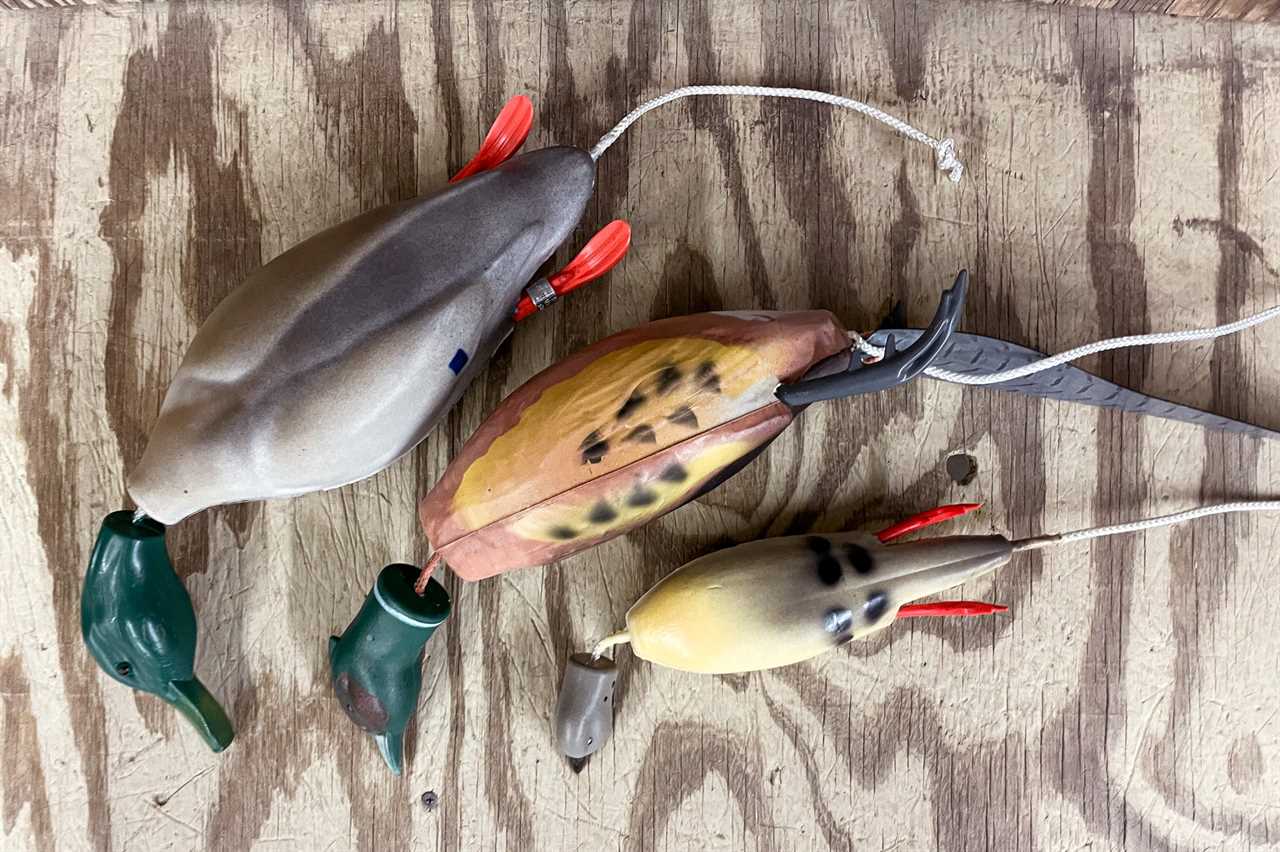
Just a few of the Dead Fowl Retrievers available. Natalie Krebs
Today, Dokken Dog Supply offers more than 30 DFTs in a dozen countries, in addition to bumpers, check cords, leashes, and other training gear, including bird scents to inject into the DFT bodies. (One year, after Tina’s Chapstick tubes kept disappearing and reappearing half-melted around the house, Dokken Dog Supply introduced a line of wax scents.)
“Tom’s number one goal is to make something–whether it’s a training technique or a training product—easy for the dog to understand and easy for the owner to be able to train the dog with,” says Tina. “His whole goal is that he wants dog owners to work with their dogs. So what’s the easiest technique to use for the dog to understand, and for the trainer or owner to be able to teach that?”
If you ask Dokken what it is about dogs that’s led him to devote his career to them, he talks first about the hunters.
“I think it’s just the fact that people are way into their dogs,” says Dokken, pointing to me and Hatchet. We’d had a breakthrough during this morning’s training session as Hatchet connected his recall lessons with the fun of retrieves. I couldn’t help laughing as my dog brought a real bird to heel without any instruction. My delight seemed to please Dokken as much as Hatchet’s progress. “You have something in common with these people because they love their dogs. Dogs are a big part of the family now, and that’s changed immensely over the years.”
There’s more to training a dog than a one-and-done transaction for Dokken. He’s interested in tracking a dog’s career over time and helping hunters troubleshoot along the way. The patience and individual lessons Dokken brings to each dog is a hallmark of his approach.
“That’s fulfilling because a lot of times most dogs won’t have much control on them at all [when you get them], so by the time you’re done with the training process and then you train their owners, they’re way grateful for it.”
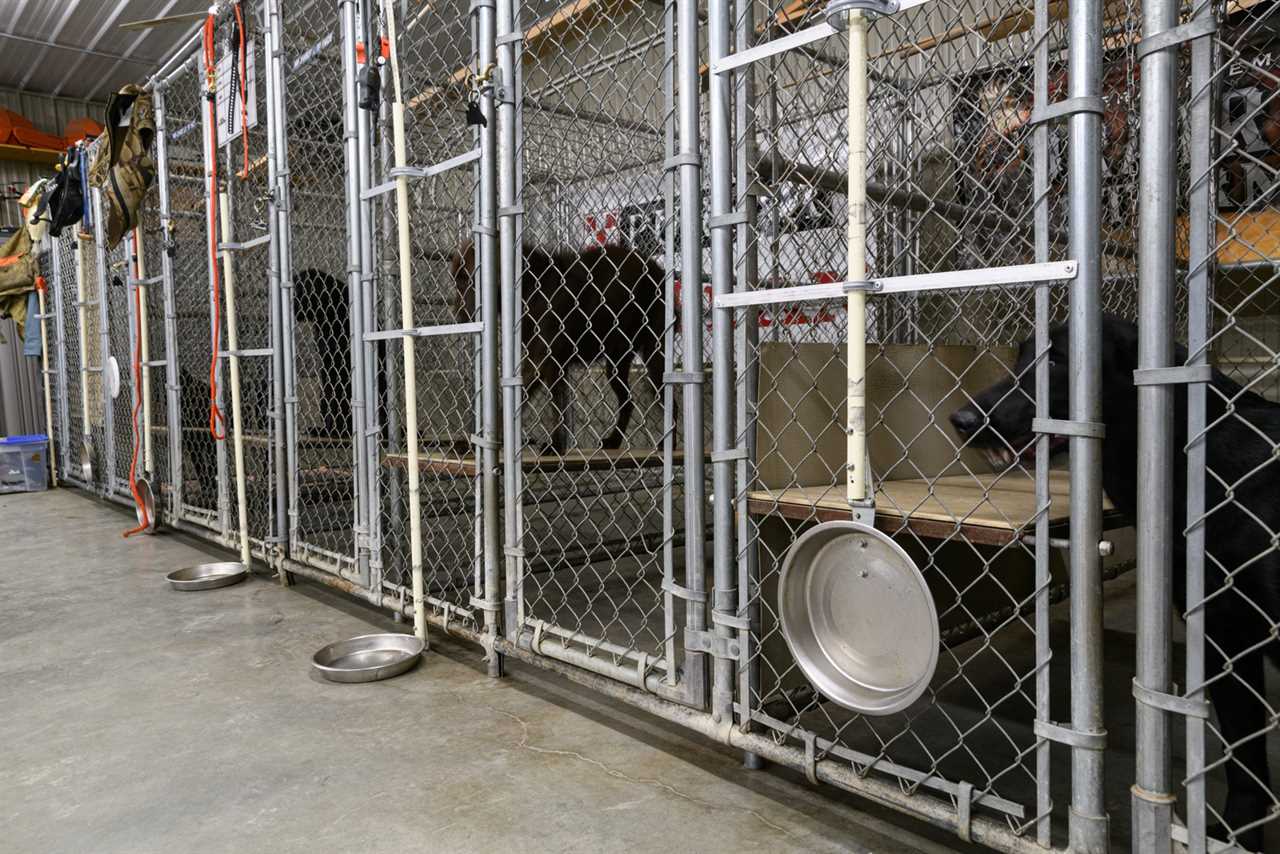
Even the feeding pans in Dokken’s kennel have been streamlined for easy use. Bill Buckley
A Solution for Everything
When the Dokkens fixed up the pre-1900 house that came with the farm, Tom and Tina filled baggies with dirt and dog hair to choose the most practical flooring. Today, their house is part hunting lodge, part kennel, and part workshop. Guests are instructed not to remove their shoes. The biggest mistake they made, Dokken likes to say, was not putting a drain inside the front door.
The inventor’s handiwork is apparent throughout the house, though nowhere more than his eight-stall kennel. Years of mucking poorly designed facilities led Dokken to rethink the traditional set up: Most trainers drop dog beds at the back of stalls, which encourages dogs to do their business near the door and their bowls. This also forces whoever has to clean the stalls to walk through the mess as they hose from back to front, toward the drains.
So Dokken rigged hanging platform beds at the front of his kennels and a concrete gutter along the back for the rare occasions it’s needed. There’s a nozzle for fresh drinking water, which dogs learn to use with a smear of peanut butter. The front of each pen is equipped with a metal food pan that snaps into place so it can be filled and swiveled underneath doors without opening them, then locked back into place once emptied. Even the kibble container has been “Dokkenized,” as Tina calls it: bags of Purina Pro Plan poured into an airtight container and seated in a wheeled platform for easy dishing.
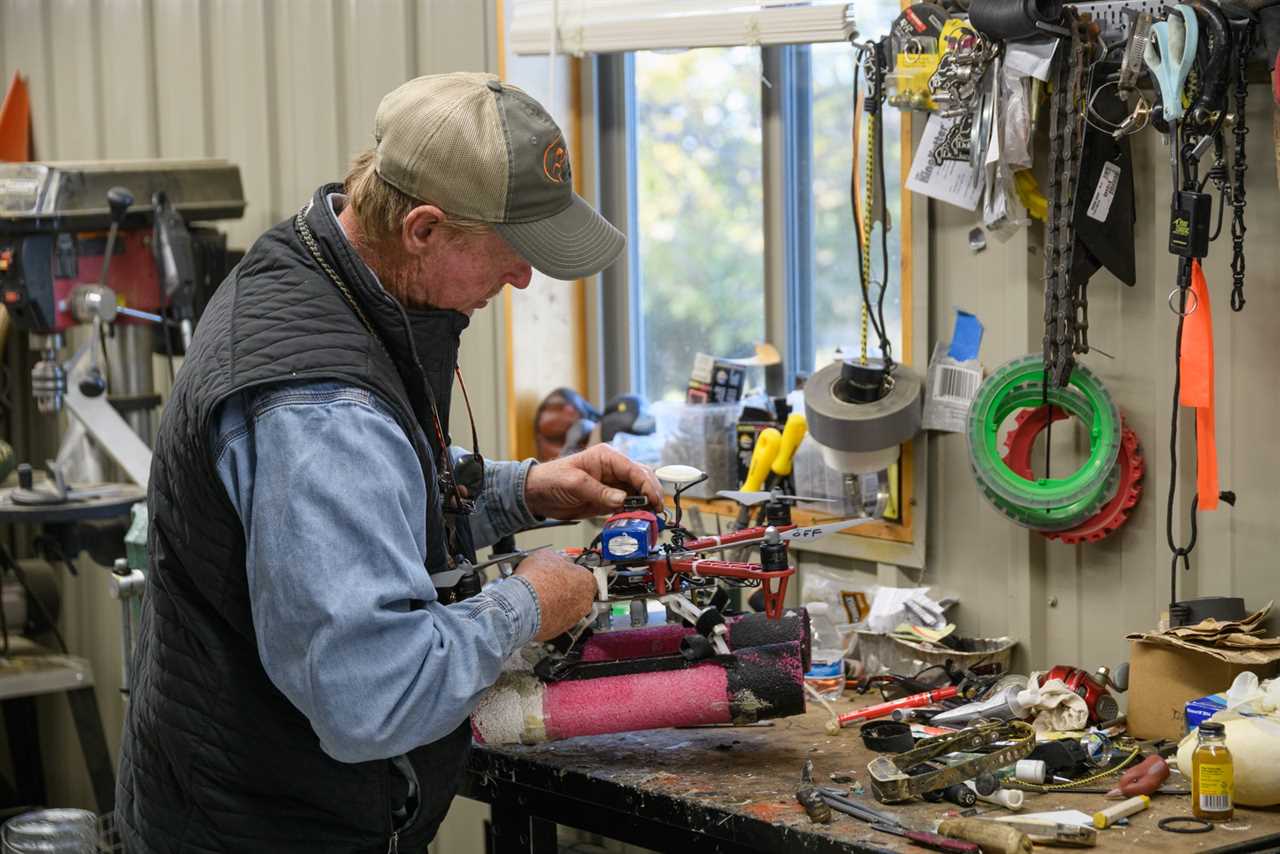
Dokken makes an adjustment to his custom training drone. Bill Buckley
The training drones Dokken designed are also stored in the kennel. Although Dokken has to be coerced into using a smart phone or a laptop, he’s become an expert drone pilot because of its usefulness as a training tool. Dokken rigged a drone to accommodate up to three dummies, which he can release over land or water with a remote. He also invented bumpers that unspool from the drone, which he’ll drag through the water to simulate an escaping cripple. (After crashing one drone into the lake by his home, Dokken added a pair of pool-noodle pontoons for emergency landings.) Just a few sessions with the drone turned my pup into a dedicated cripple hunter who watches the sky for birds.
Hanging near the kennel’s back door is a wooden contraption that looks like a shotgun but accommodates a .22 blank pistol to smooth a pup’s transition to louder reports. Beside that is Dokken’s battered Browning Citori. A strip of Velcro keeps the barrel selector in place; another on the safety that makes it easier to manipulate with gloves. Two more strips run along the fore-end for easy e-collar remote access. (This comes in handy while training steadiness to shot or trying to hunt with a younger dog.) A pair of giant dents have flattened the rib to the barrel.
“Who cares what it looks like?” Dokken says of a philosophy that extends well beyond his shotgun. “It works.”
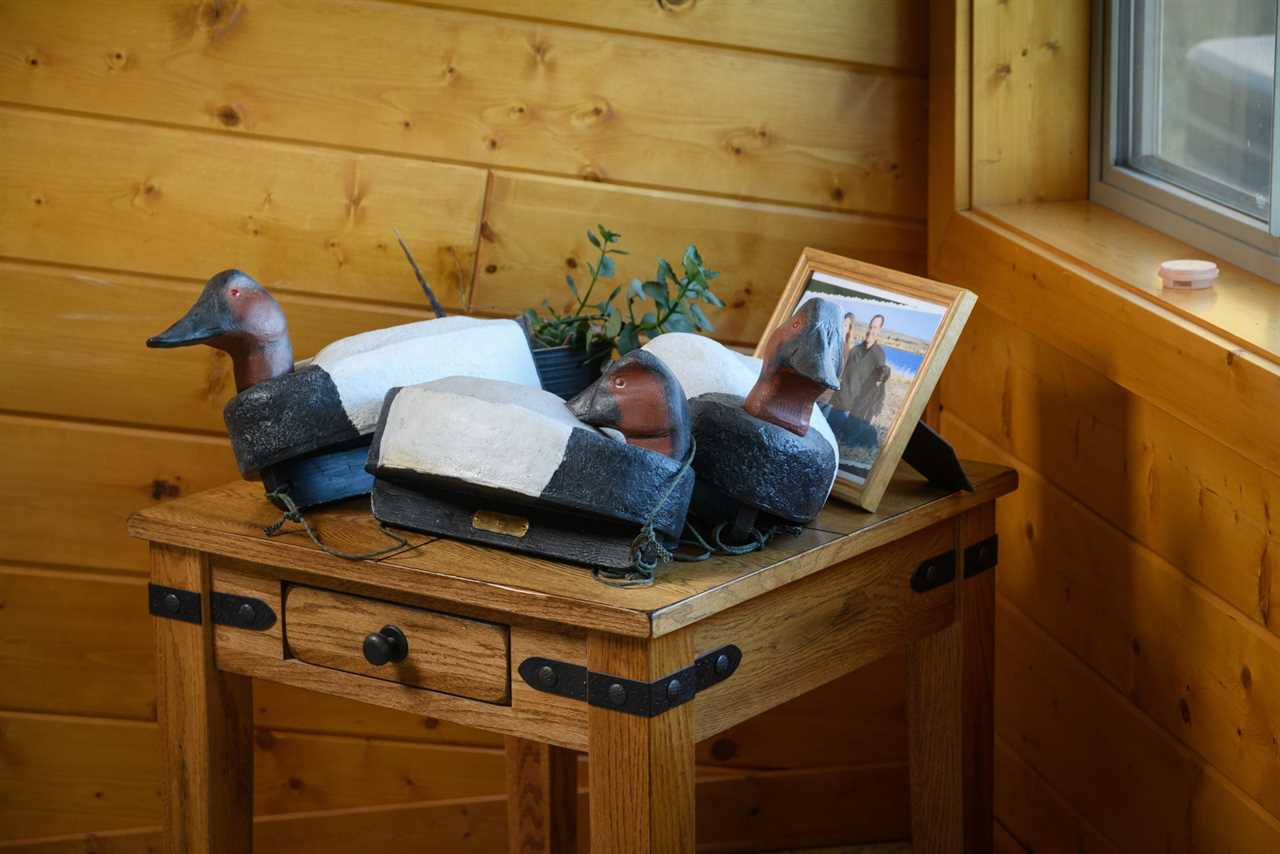
Hand-carved canvasback decoys that hold the ashes of the Dokken’s gun dogs. Bill Buckley
Even his sentimentality is functional. Outside his workshop, a table holds three hand-carved canvasback decoys. They’re not finely shaped or all that well painted, but inside each are the ashes of their old dogs, with each Lab’s name inscribed on the keel: Sam, Sage, Rookie. Although Dokken leaves out plastic decoys in the sloughs near the house, he sets these with care some mornings so he and his wife can still hunt over their dogs.
When Tina brings home the puppy that will become her fourth bird dog, Tom doesn’t run to greet them as I do. Instead, he sinks to the grass and stretches onto his back. The pup’s shyness dissolves into curiosity as she clambers onto his chest. Within days there will be foam and cut-down DFTs around the house, the scraps of a true puppy dummy in the making. But today he just rests in the fall sunshine, his face breaking into a hint of a smile as he welcomes another dog into the fold.
The post Tom Dokken Is the Godfather of Retriever Training in America appeared first on Outdoor Life.
By: Natalie Krebs
Title: Tom Dokken Is the Godfather of Retriever Training in America
Sourced From: www.outdoorlife.com/hunting/tom-dokken-retriever-training-philosophy/
Published Date: Fri, 21 Oct 2022 22:00:00 +0000
----------------------------------------------
Did you miss our previous article...
https://manstuffnews.com/weekend-warriors/the-best-midpriced-hunting-rifles-put-to-the-test
 Backyard GrillingWeekend WarriorsAdvice from DadBeard GroomingTV Shows for Guys4x4 Off-Road CarsMens FashionSports NewsAncient Archeology World NewsPrivacy PolicyTerms And Conditions
Backyard GrillingWeekend WarriorsAdvice from DadBeard GroomingTV Shows for Guys4x4 Off-Road CarsMens FashionSports NewsAncient Archeology World NewsPrivacy PolicyTerms And Conditions
